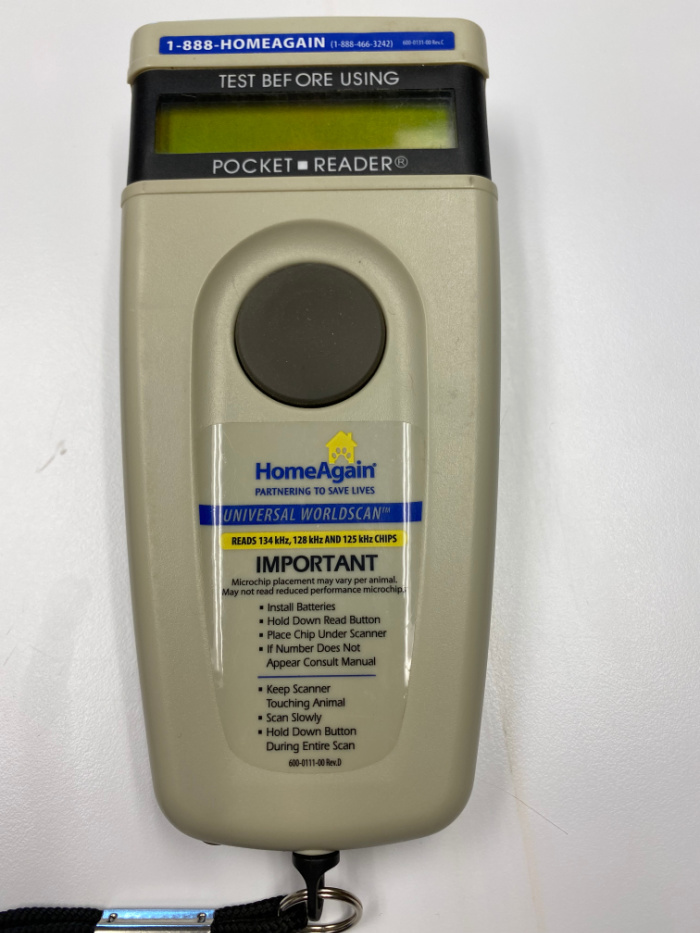With the start of a new year, we begin a new theme for blogs. Looking back over the past years it does become a little more challenging to discover new things to discuss. Decided to talk about the different tools that can be used to assist us with our daily tasks as veterinarians.
The first tool that we use quite frequently is an ISO microchip scanner. When microchips were introduced, each company had a chip and a scanner. That was clumsy because scanners would only read their companies chips or certain frequencies. Therefore, a chip may have been missed by a shelter or veterinary office unless they had multiple scanners. The International Standards Organization (ISO) approved and recommended a global standard for microchips. At that time, it was also decided that chips should have 15 numbers and no letters. They would be called universal chips and would be accepted worldwide. All chips would also be read with a forward and backward universal scanner. The ISO frequency is 134.2kHz. There are 125kHz and 128 kHz chips still implanted in dogs. They are not acceptable to travel worldwide but most universal scanners will detect the chip number if the pet is scanned properly. Earlier chips had a tendency to migrate once implanted. The new universal chips will not migrate. If scanning a pet be certain to scan over the entire body just in case they were chipped with an earlier version of microchips.
At this time no company has microchips that have GPS trackers on them. There are collars that come with tracking devices but as for a microchip that is implanted and trackable, that technology is not available. The size of the GPS tracker and its need to be charged does not allow for this to be implanted under the skin of an animal. The following link is one source that is available if you are interested in tracking your dog’s movements. There are usually costs associated with the tracking so be aware of that as you are considering this type of technology.
https://tractive.com/en/pd/gps-tracker-dog
We can place microchips under the skin above the shoulder blades on any animal during a routine exam. The microchips we provide are from Home Again. Once the chip has been placed, we register the chip with Home Again to safeguard that information is available should the pet ever get lost. It is important that owners update this information should addresses or phone numbers change. We have had situations where a lost pet is brought to Winterset Veterinary Center and we find a microchip number but it is registered to a person in California. We know that animal did not walk from California to Iowa. Updating this information is as important as notifying the Post Office of an address change. In a few situations a pet has 2 microchips. Please register both chips. When a pet is scanned the first number it picks up is the one searched. No one suspects a second chip being present. Therefore you must register both numbers. This can happen from a pet being lost and a chip migrates so it is missed and when adopted out a new chip is placed. I also had a puppy that had 2 chips – both placed from the breeder. Apparently one puppy got two chips and another did not have one. It can happen so just make certain to register both chips if you find out your pet has more than one chip.
Many people fear that the microchip carries important information that could affect ones privacy. This is not true. The only information gathered from the chip reader is the 15 digit number and recently I was able to get the pets body temperature from the chip. That beats a rectal or ear thermometer any day! All personal information is kept confidential by the company that registered your pet’s microchip.
For under $50 a microchip can be placed and registered to safeguard your pet gets home should they ever decide to wander off. We have had dogs all sizes, ages, shapes, and colors, come to us as lost pets. The reunion happens quickly if a chip is discovered. Without a chip, the distance a dog can travel in a short period of time makes that reunion much less likely. Statistics have shown that 15% of dog and cat owners will lose their pets. Dogs have a recovery rate of 93% but cats are only at 75%. Dogs seem to wander away more than once. Cats not wearing ID collars because they are considered “only indoors” is a big concern. In one study 41% of the owners who were searching for their lost cat reported the cat was indoor only. Cats wearing a collar with an ID tag is a great method to improve reunion of cats with their owners. All pets should be microchipped as a way to improve a lost pet being reunited with their family.
Any microchip can be registered with the Home Again’s registry if you wish. You can register with multiple registry’s. American Animal Hospital Association (AAHA) has a microchip lookup online site where you may search microchip numbers of found pets. If you have found a pet you are able to enter the chip number and it will give you a phone number to the proper site so a pet may get home safely. Again your personal information is protected and that of your pet. It is designed to reunite pets with their families as quickly as possible.
All pets should be microchipped if you want to assure they find their way home to you. One is never assured that even an indoor only cat or a tiny dog would not wander off someday. I once had a person ask my why their 8 year old neutered male boxer ran away. He had never done something like that in the past. This owner was worried but also confused about why? I had no answer for him and as you might guess there was no collar or chip with identification on it.
Place a microchip in your pet. Get ID on the collar of your pet. Start kittens with collars at a young age so you can have ID on them as well. Last week I saw a client that had her phone number embroidered on her cats’ break away collars. She is not leaving it to chance. She wants to make certain her cats get back home if they were ever to get lost.
If you have more questions about microchips feel free to contact me at Winterset Veterinary Center during regular business hours or the article below has some additional information about frequently asked questions.
Please do not let your pet go out unprotected. Their ability to get home depends on you. A microchip is a pet insurance that is priceless were you ever faced with a lost pet.

